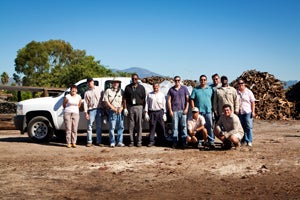

On Wednesday, November 03, 2010, a team of scientists from CISR, CDFA, UCCE, USDA-APHIS, the Orange and San Diego County Agricultural Commissioner’s Offices and West Coast Arborists returned to the Red Palm Weevil (RPW) affected site in Laguna Beach California.Inspection of a unhealthy Canary Islands palm the previous week resulted in the discovery of a live adult RPW in the trunk. Discussions concluded that the infected tree should be removed to prevent the continued possible breeding and spread of the RPW from that palm to other areas in the immediate vicinity.
The two main goals of the CDFA-sponsored project were: (1) removal and destruction of the RPW infested palm, and (2) to dissect the palm and determine how deep the infestation had proceeded through the trunk of the infested palm. It was decided that dissection of the palm could provide useful information on the level of RPW infestation in the trunk, if any live stages were still present, and how severe the internal damage was.
The palm was removed at its base and the trunk was carefully wrapped in heavy plastic sheeting and sealed with tape to prevent accidental escapes by RPW adults during transportation to the dissection site. The wrapped trunk was loaded onto a truck and transported to the city of Irvine, a designated and pre-approved dissection area a few miles away. Here, more plastic tarps and sheeting were placed on the ground to contain and prevent the unwanted escape of any RPW larva, pupae, or adults in the palm trunk once the cutting of the palm started.
First, the remaining palm fronds were removed from the trunk. This revealed many telltale signs of RPW activity. RPW tunneling had completely scarred the base of the fronds. The location of this damage was below that which an arborist would trim, making early detection of RPW difficult. Empty RPW cocoons were found at the cut ends of fronds where they had been attached to the trunk. These cocoons were again below the cut line making detection difficult.

Most of the visible RPW damage to the palm was towards the top of the trunk. Starting at the top of the trunk, 4 to 8 inch slices of palm trunk were cut in sequence towards the base. The slices allowed examination of the internal damage RPW had caused to the trunk. The first few cut slices showed extensive RPW damage. The center had been hollowed out by RPW feeding, leaving a large empty space the width of a basketball. The inside walls of the trunk had extensive grooves from tunneling RPW larvae, which likely further weakened the palm. Instead of the hard fiber-like center typical for healthy palms, RPW feeding had left a soft degenerated mash of wet, fiber like sawdust that was very smelly.
The trunk slices were continued for about 3 or 4 feet before the solid undamaged central trunk mass was encountered. Further cuts into this area produced no further evidence of the RPW infestation. The remaining uninfested and damaged trunk sections were cut into small blocks. These blocks together with the fronds, and all other clippings, and shavings from the palm were double bagged in thick plastic and then sealed. The bagged remains of the dissected palm where transported to a landfill waste refuse site for immediate deep burial.
During the dissection process NO live RPW adults or larvae were found. Several RPW cocoons were pulled from the palm. The majority of these cocoons were empty, but a few had dead pupae that had failed to reach adulthood, or the cocoons contained a few incomplete body pieces. Many partial bodies of RPW adults were also found during the dissection. With so much visible internal and external damage to this palm, it begs the question, where did the adults go?